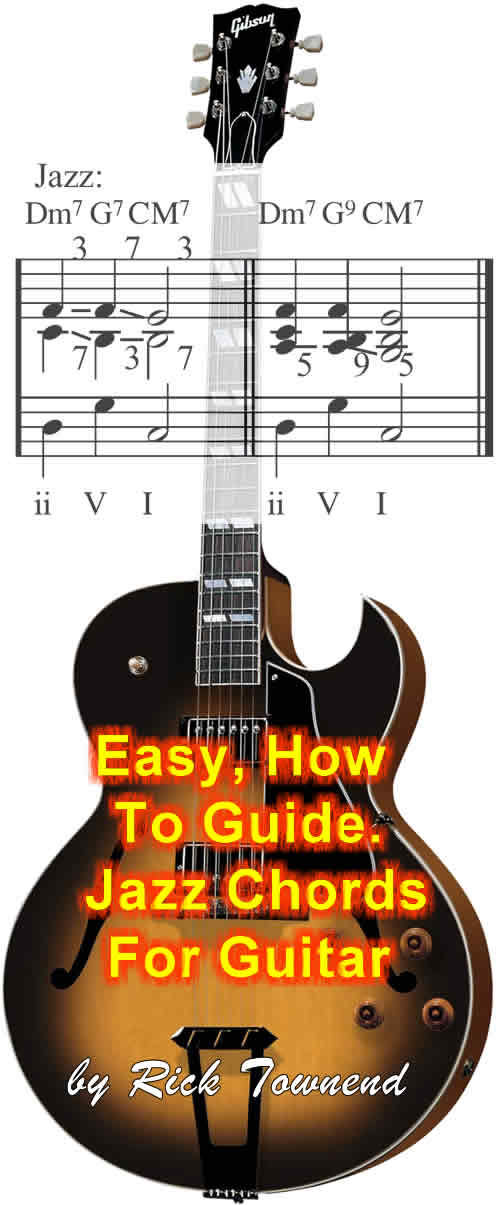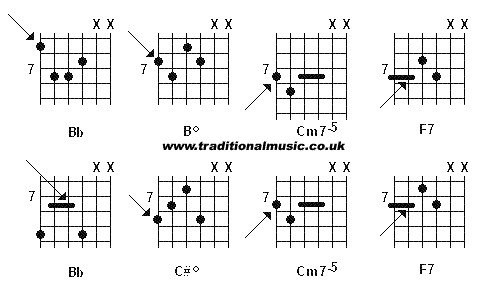Learn a bit about Jazz Chords for guitar
Easy How-to guide by Rick Townend
| Share page | Visit Us On FB |

For people who have learned folk or bluegrass guitar, jazz is usually a completely different field, seeming to have its own unfamiliar rules of play. Actually, it's not hard to get to grips with the chord basis of 'mainstream jazz' - the songs and tunes of the 1920s-1950s, played and sung by artistes like Benny Goodman, Billie Holiday, Duke Ellington, and (on guitar) by Django Reinhardt and Eddie Lang; Eddie's real name, by the way, was Salvatore Massaro - like his violinist friend Joe Venuti his family were immigrants from Europe to America.
Almost all mainstream jazz is in 4/4 - four strums to the bar. Almost all jazz players include the familiar 12-bar blues in their repertoire - e.g (a 12-bar blues in 'G'):
| G | G | G | G7 |
| C | C | G | G |
| D7 | D7 | G | G |
However, the vast bulk of mainstream jazz tunes are one of two kinds of chord sequence:
1 -a 16 or 32 bar pattern is played twice,
the main theme being repeated, but the first time through ending in (for a tune
in G) D7, and the second time changed a bit to resolve into G; for example
- 'Running
Wild' (slightly simplified):
G |
G |
G |
G7 |
C |
C |
G |
G |
B7 |
B7 |
Em |
Em |
A7 |
A7 |
D7 |
D7 |
| |||
G |
G |
G |
G7 |
C |
C |
B7 |
B7 |
C |
C |
G |
E7 |
A7 |
D7 |
G |
G |
2 - an 8 or 16 bar pattern is played, then repeated, then a 'bridge' section (or 'middle-8'), then back to the first pattern. This is sometimes called 'AABA'. For example - 'Ain't Mis-behavin'':
G |
Am7 / D7 |
G |
C / Cm |
G |
Am7 / D7 |
G |
(Am7/ D7) |
| |||
G |
Am7 / D7 |
G |
C / Cm |
G |
Am7 / D7 |
G |
G |
Bridge: | |||
Em |
C |
A |
E7 |
D |
Em / A7 |
D / E7 |
A7 / D7 |
| |||
G |
Am7 / D7 |
G |
C / Cm |
G |
Am7 / D7 |
G |
G |
Note: where there are two 'chords' separated by a '/' play two beats for each; otherwise four strums for each bar.
You can play rhythm guitar for these songs using the familiar 'open' chord shapes which I expect you already know. However, many jazz tunes played in the 'flat' keys - F, Bb and Eb - because this suits the trumpet, sax and clarinet, and also it's actually easier and more fun to play the chords up the guitar neck, in 'closed' shapes - where all the strings played are fretted. Note: many, maybe most, jazz guitar chords don't use all six strings. So you don't have to have six fingers! Also, up the neck the frets are closer together, so you have to stretch less. Finally, because all strings played are fretted, it's really easy to change key if, for instance, the singer needs the song to be a bit lower or higher than usual; just play everything a fret or two lower or higher than usual. For this and other reasons you'll find that you don't actually need to know the names of all the chords you are playing - just their relative positions to each other, and the way they lead from one into another. For, as you'll soon discover, this type of jazz has a very predictable and familiar basis of how the chord patterns work.
One thing you'll notice if you play 'mainstream' jazz is that the 'going-home chord' (D in the key of G) is usually made into a seventh (D7), because this seems to make it 'want' to change back to the key-chord - try it and see. Jazz uses 7th chords a lot to indicate a chord change coming up - e.g. A7 to D7 to G or Am7 to D7 to G. You can also use 'decorative' chords - for example you can get from G to Am7 via a G# diminished chord (G#o): G to G#o (g#+b+d+f) to Am7. Jazz uses diminished chords a lot; don't be frightened - it's a familiar sound, and they're easy to play! There are some examples of diminished chord shapes just coming up, or you can get them from a book or the internet.
Starting Off
With this kind of jazz you usually start off a number with four bars to set the tempo and mood, and often it's up to the guitarist to do this. So, for the first practical example of some actual jazz chords, see the box. Each shape is played for two beats, so - two shapes to the bar: eight shapes = four bars. The shapes are in the key of Bb - the '7' at the side is the number of the fret: the 7th fret is an important one, usually with a good-sized inlay in the neck. Bb is a common jazz key and also, as I said, the frets are closer together up the neck. However, if you like you can play this sequence in G by changing the fret indicator on the shapes from 7 to 4.
If you have a go at these shapes you should find that they're not that hard - they are all just on the bottom four strings - don't play the strings marked 'X'. Some of the shapes will be familiar to you as parts of chords you already know. The sound should also be familiar. Don't bother specially about learning the chord names, they are just there for reference. It'll be more useful in the long run to get to know these shapes and how they sound. You may like to try using different combinations of left-hand fingers to make the chord shapes; see what suits you, and what's easiest for changing to the next shape.
You may find that the most difficult thing is how not to play the strings marked 'X'. It may take a bit of time, but after a bit you will get familiar with just strumming 4 strings with your right hand, and also learning to damp the unwanted strings with a spare bit of your left hand.

Notes:
To buy Books about Jazz for Guitar check the Jazz Guitar Collection at Sheet Music Plus.
You may also be interested in other Jazz related Items on this site:
The following related items may also be of Interest
12 bar blues on any instrument, a basic guide by Rick Townend. Jazz Chords for guitar, A simple guide by Rick Townend.
Teach Yourself Jazz - an introduction for musicians wishing to add jazz to their playing styles. EXTEMPORE PLAYING tutorial - 40 Lessons, how to correctly play improvisations